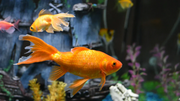
You scoop a bright gold comet from the pet-store tank, bring it home in triumph, and set the bag in a glass bowl on the counter. A week later you’re flushing a limp body and wondering: "Why does my goldfish keep dying?" It feels cruel, mysterious, even embarrassing. Take heart: goldfish are hardy, but modern myths about bowls, flakes, and “no maintenance” setups doom more fish than disease ever could. By the end of this guide you’ll know how can I tell if my goldfish is dying, what pushes a sturdy carp to the brink, and how to save a goldfish that is dying—with a few solar-powered Poposoap tricks that let you keep them thriving indoors or out.
Goldfish Are Tough — But Not Invincible
Descendants of Asian carp, goldfish tolerate cold, low oxygen, and even brief ammonia spikes better than tropical tetras. That resilience lulls keepers into believing a one-gallon vase are “fine.” It isn’t. Tiny volumes swing chemistry fast, and once stress sets in, hardy turns fragile surprisingly quickly.
Section 1: Signs That Your Goldfish Might Be Dying
Before you can rescue a fish, you must recognize trouble early. Look for:
- Gasping at the surface or hovering under the waterfall lip.
- Clamped fins held tight against the body rather than fanned.
- Red or black streaks on fins—a burn from ammonia or nitrite.
- White fuzz (fungus) or pinhead white spots (Ich parasites).
- Erratic swimming, sudden dashes, or listless sinking.
Ask yourself daily: "How can I tell if my goldfish is dying?" Any behavior you haven’t seen before deserves a water-test strip and a closer look.
Section 2: Why Do Goldfish Keep Dying?
Below are the “Big Five” killers. If you’re muttering "Why do my goldfish keep dying" every few months, one of these is almost always in play.
1. Poor Water Quality

Ammonia, nitrite, or untreated chlorine scour delicate gill tissue. In an unfiltered bowl, measurable ammonia can appear within 48 hours. Partial water changes (25 %) every other day help, but the real fix is a proper filter with mechanical and biological media.
2. Overfeeding
Goldfish beg like puppies, and most owners oblige. Excess flakes sink, rot, and release ammonia. Rule of thumb: what they finish in two minutes, once or twice a day. Remove leftovers with a net.

3. Tank or Pond Too Small
One juvenile goldfish needs at least 10 gallons. A common comet can exceed 10 inches, meaning a 55-gallon tank—or a patio tub—quickly becomes more humane. Crowding stunts growth, compresses the immune system, and explains why "Does my goldfish keep dying" even when water tests “look okay.”
4. Lack of Oxygen
Warm rooms and stagnant bowls strip dissolved oxygen, causing lethargy and surface gulping. Drop in a Poposoap solar pond aerator or a micro floating fountain; both run day-solar, battery-night, so cords never clutter the living-room shelf.
5. New Tank Syndrome
Crystal water fools beginners. A freshly filled tank has zero nitrifying bacteria, so the first ammonia surge has nowhere to convert. Always “cycle” a new setup—run the filter for two to four weeks with bottled bacteria or a pinch of food before adding fish.
Section 3: How to Save a Dying Goldfish
If your fish is already listing sideways, act fast:
- Test parameters. Ammonia or nitrite above 0.25 ppm demands an immediate 50 % water change with dechlorinated water matched for temperature.
- Boost oxygen. Point an existing filter outlet so it ripples the surface; add an emergency air stone or a Poposoap solar bubbler if outdoors.
- Stop feeding for 24 hours. Digestive rest prevents extra waste while the bio-filter catches up.
- Add beneficial bacteria. Refrigerated strains colonize quickly and blunt toxin spikes.
- Isolate if infected. For visible fungus or Ich, move the fish to a hospital tub dosed per medication instructions—never treat the main pond unless all residents show symptoms.
These steps answer the urgent search "How to save a goldfish that is dying" and buy time for long-term fixes.
Section 4: How to Keep Goldfish Alive Long-Term
So, how do you keep goldfish alive year after year? Build a system, not a décor piece.

- Upgrade volume. A 20-gallon tote on a patio beats any glass bowl. Better yet, a 100-gallon whiskey barrel with a Poposoap compact filter and solar fountain turns outdoor space into a low-maintenance mini-pond.
- Filter correctly. Choose a unit rated for double your volume; goldfish are messy. Poposoap’s all-in-one boxes hide under gravel shelves and run on daylight—perfect for balcony tubs lacking outlets.
- Aerate. Moving water resists algae and delivers oxygen. Floating solar fountains add vertical drama while breaking surface films.
- Test weekly. pH 7–8, ammonia 0, nitrite 0, nitrate under 40 ppm keeps gills pink and fins upright.
- Feed color-safe rations. High-quality sinking pellets reduce surface oils and contain stabilized vitamin C for immunity.
- Provide shade. In full sun, water can spike to 90 °F. Lily pads, floating lettuce, or a pergola drop temps and ease oxygen demand.
- Quarantine newcomers. Parasites hitchhike; a two-week tub with a small sponge filter prevents outbreaks.
Implementing these habits once settles the relentless cycle of purchase-and-loss that fuels the question "Why do my goldfish keep dying?".
Conclusion: Goldfish Can Thrive with the Right Setup
Goldfish deaths rarely stem from rare diseases or bad luck; 90 % trace to husbandry slip-ups entirely in our control. Now you know why your goldfish keeps dying and possess the checklist to turn things around: ample water, clean filtration, restrained feeding, stable chemistry, and steady oxygen. Solar-powered Poposoap pumps and filters make many of these fixes cord-free and budget-friendly, whether you keep a desktop tub or a backyard barrel. With a proper environment, these resilient carp can outlive your family dog—proof that “tough” doesn’t have to mean expendable.










